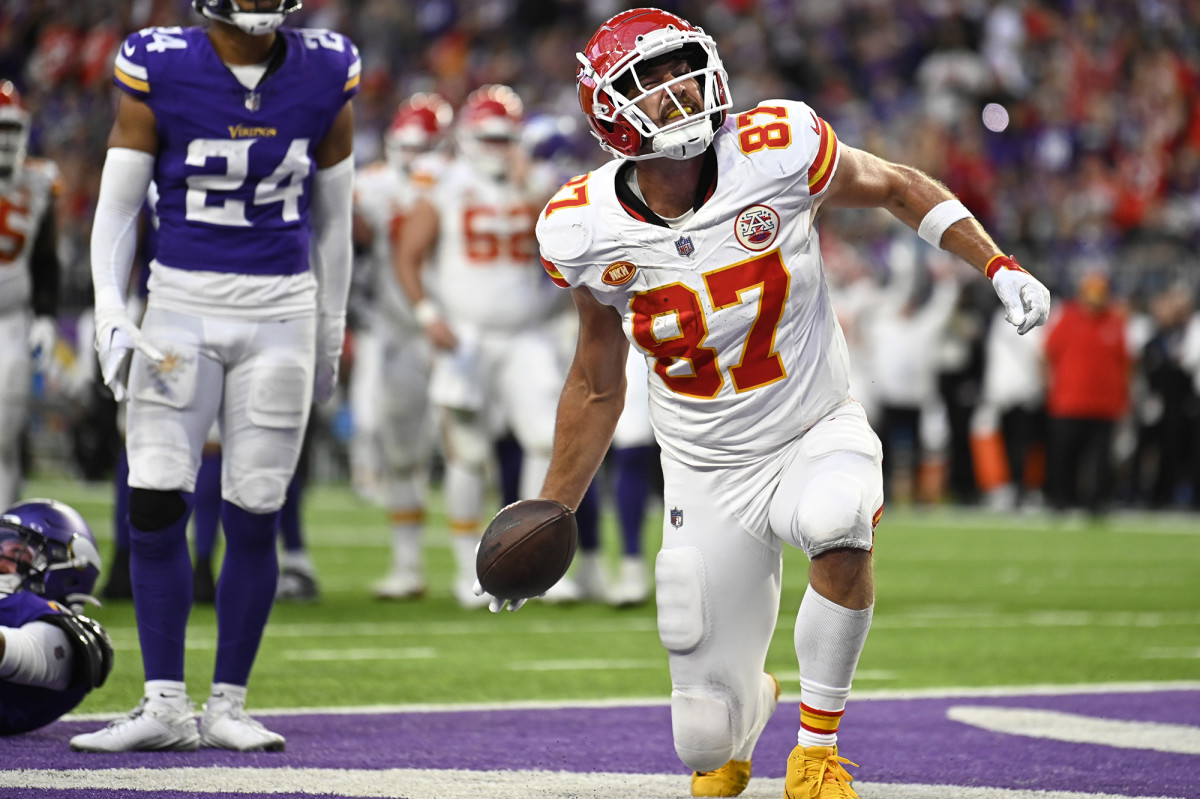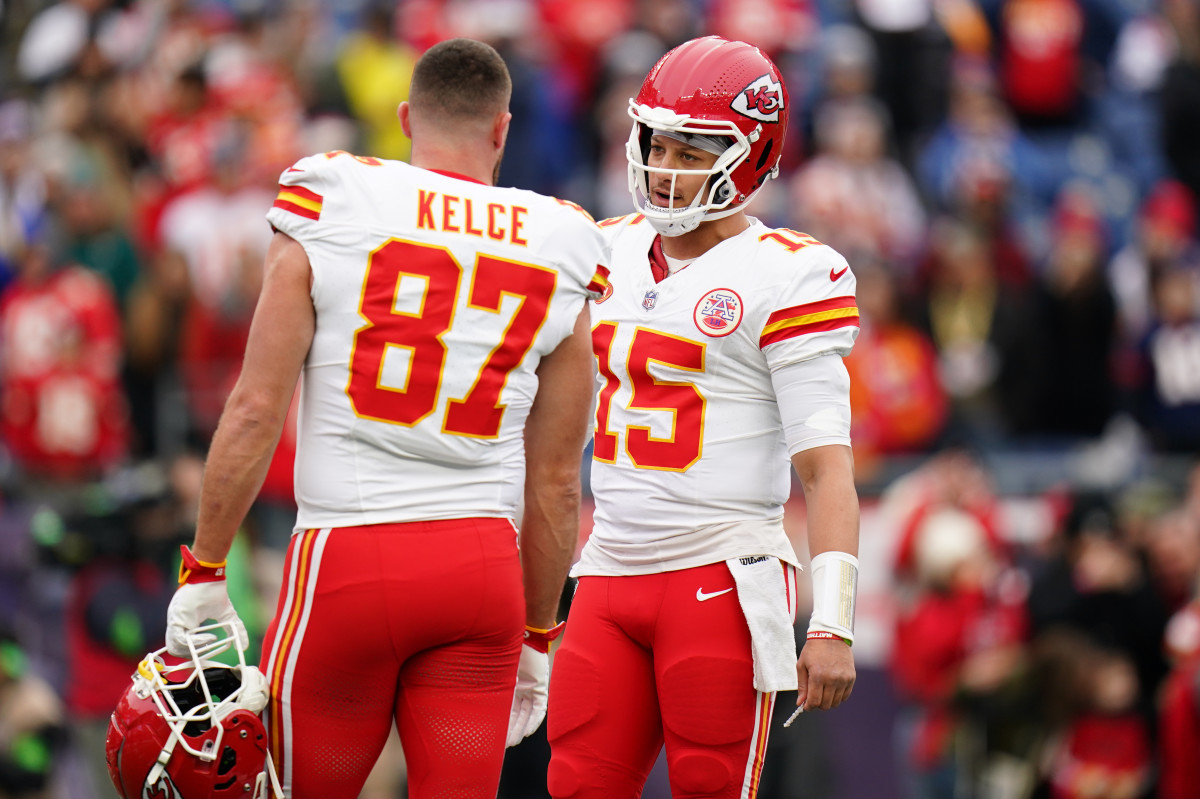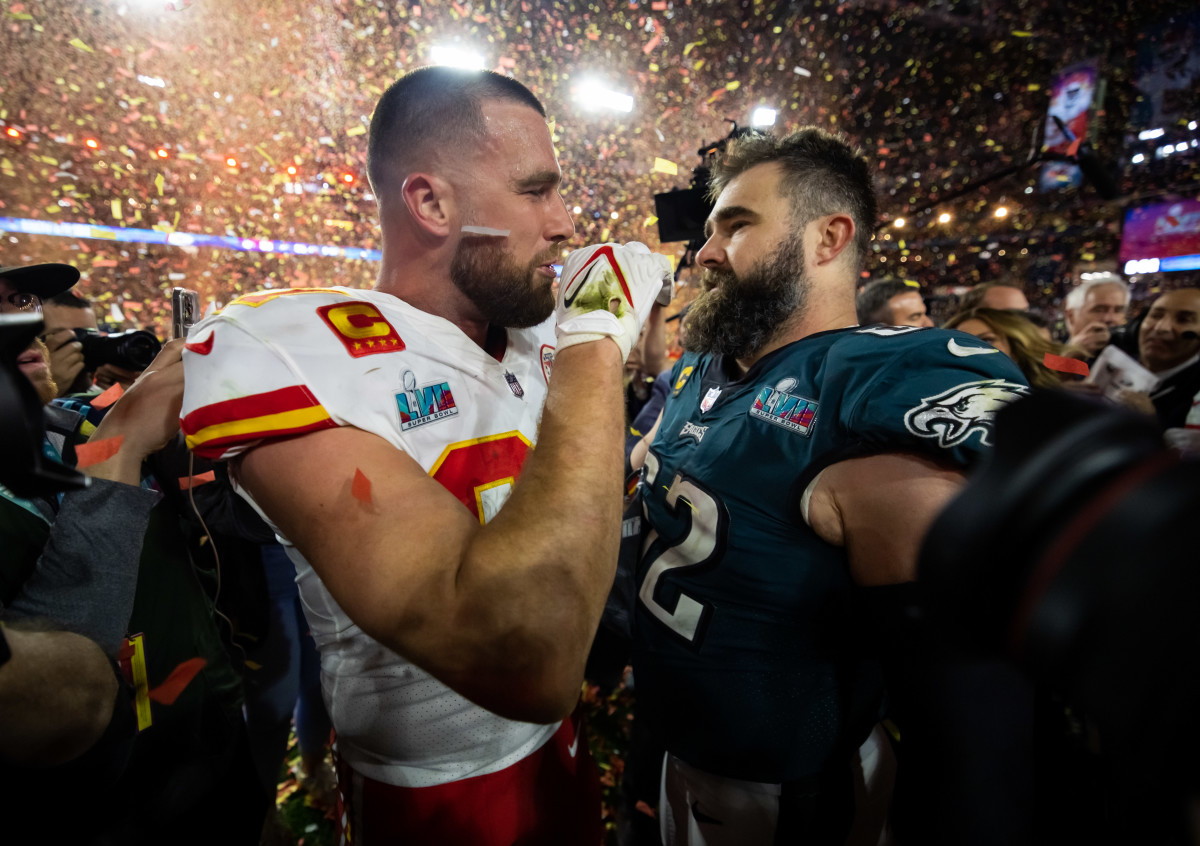Travis Kelce’s 2023 End Game

How did the tight end position arrive here? With Travis Kelce walking down a hallway wearing selections from his massive wardrobe full of opulent Marni tops and Thom Browne pants, hands clasped with the world’s biggest pop star, Taylor Swift. Together, they shine like quasars, dominating the tabloids and melting the hearts of Swifties and (at least some) football fans alike.
This used to be the position of Mike Ditka, of puggle-faced men with flat-top haircuts straighter than concrete countertops. Of Dan Campbell, who sounds like an industrial machine when he talks and looks like he deadlifts Cadillacs.
Kelce is different. Like the great quarterback pitchmen of our time, he is omnipresent. He has become un-ignorable. He is hawking insurance, hot soup and pharmaceuticals. He cohosts the top sports podcast in the country with his older brother, Eagles center Jason. Donna Kelce has become the most recognizable mom in America. He is part John Cena, part John Candy, part John Wayne.
Kelce has been a star in the football universe for years. Now?

“My mother called me the other day and said, ‘Did you see that Travis is going to Argentina to see Taylor Swift?’ ” says Jenna Lemoncelli, a crossover sports and entertainment reporter for the gossip powerhouse New York Post. “If you had asked her a few months ago who Travis Kelce was, she’d ask, ‘Is that a store?’ ”
Lemoncelli, who points out that People is covering even the most routine of Kelce’s on-field receptions, says the Chief could “sneeze a certain way” and it would be “our No. 1 story, all day and all night.”
But as the Year of Kelce comes to an end, it’s important to note that we would not be where we are without his absolute and total football brilliance. Kelce has changed what is possible for tight ends off the field because he has transformed the position on it. Now in his 11th season, twice a Super Bowl champion, four times a first-team All-Pro, eight times a Pro Bowler, Kelce has cemented himself as one of the greatest tight ends in NFL history. Choose your preferred forum for a proper sports debate. Mount Rushmore? Top five? Dream Team? Kelce is there, not just merely in the conversation but dominating it.
Sometimes greatness is as simple as someone being bigger and stronger and faster, a lapse in some universal gene disbursement program that ended up handing all the good stuff to a singular human. In Kelce’s case, those who study the position deeply argue it is more Darwinian. About two decades ago, the tight end position began to shift.
Kelce was part of a small group of nomads who helped figure that out and changed the layout of a football field forever. In this way, Kelce and Swift pleasantly ducking the aim of celebrity photographers and pecking each other on the cheek is not just kindling for gawking eyes—some seemingly manufactured combination of entertainment monoliths exploiting their mutual interests—but also the finished stages of the tight end’s growth from Australopithecus to Homo sapiens.
Recruiters say it has never been easier to persuade kids to switch to tight end after having it be considered a bit of a career death sentence of blocking misery, while it seems defensive coordinators have never had a more difficult time handling what Kelce has helped the NFL morph into.
When one thinks of it that way, Kelce’s oeuvre is befitting of the star treatment. Our path here is worth revisiting.
“Kelce is an enigma. He’s a unicorn,” says Dallas Clark, one of the top tight ends of the 2000s and a deep thinker on the state of the position. “He’s one of those special ones.”
Clark says that, just as modern children will never be able to understand life before cellphones, youth football players today will never be able to understand the game before Kelce. It’s never going back.
Due to the notoriously scrambled nature of high school football—fast, spread-out offenses focused primarily on speed and survival—a good tight end is not necessarily born and raised but uncovered later in life.
The proliferation of spread offenses—a more pass-heavy version of football that relies principally on speed and spacing and less on brute force—in the late 1990s sliced the prospective recruiting pool of tight ends in half. Traditional pro-style tight ends of the time, kids who could top out at 270 pounds and frequently be counted on to block, were more desirable as offensive linemen given that teams demanded more athleticism from their every-down blockers.
Around the same time, the hoarding of wide receiver talent became a means of survival for major college programs. The position was over-recruited. Schools that might devote eight scholarships to wide receivers were now keeping a dozen, creating a market premium but also reducing the number of scholarships awarded to tight ends and fullbacks.
So suddenly there was a glut of 6'4" kids who didn’t want to (or couldn’t) play tackle, or were perhaps a little too slow to be a wide receiver (such as current 49ers star George Kittle), or, in Kelce’s case, quarterbacks who were not going to project as such at the next level. They could all be scooped up by programs looking to even the playing field.
“What you’re looking for is not a finished product,” says Brandon Blaney, a longtime tight ends coach who currently works at Eastern Michigan. “They are late bloomers, young in their appearance, kids playing multiple sports.”
Blaney was on the Kansas staff in the mid-2000s that recruited Kelce as a pure tight end. Kelce was a quarterback at Cleveland Heights (Ohio) High, where he was also a standout basketball player who once harbored dreams of being a two-sport athlete for Cincinnati. He passed on the Jayhawks and played sparingly as a wildcat quarterback for the Bearcats before getting kicked off the team for failing a marijuana test. Among the requirements for his reentry into the program: a position change.
To those who had coveted Kelce as a pass catcher since high school, the move was obvious. Recruiters often say that watching kids play other sports, like basketball, is a far better projection tool for a tight end than seeing them play football. How do their feet move? Can they dunk? Are they explosive? Do they initiate and welcome contact? Kelce’s high school basketball coach had to impose a dribble limit because his biggest and most dominant player was capable of running the point.
“I mean, look at the kid’s head. He had a big head, too,” Blaney said, referring to the actual size of Kelce’s cranium. “That tells you he’s going to start to really fill out.”
When the projection is successful, the product is an athlete who can perform the tasks necessary to play tight end while maintaining the DNA of their experiences before life as a tight end.
Kelce’s coaches with the Chiefs provided two examples of his unique combination of power, finesse and game understanding, both of which did not involve Kelce even touching the football. Plays like these, they say, often get obscured by his highlight catches.
First-and-10 against the Texans in an AFC divisional round game in January 2020, with the Chiefs trailing 24–0 early in the second quarter. At the snap, Kelce is lined up on the left, tight to the line of scrimmage. There are a linebacker and a safety directly over the top of him, the former, presumably, to cover Kelce, and the latter to pick up running back Damien Williams should he come out of the backfield and run a passing route.
Before the snap, Kelce hears the defensive call and deciphers exactly how the Texans plan to play him. He also knows that Williams is going to run a route in a space near where Kelce is going. So, without prior instruction, Kelce smashes his route into the linebacker, Jacob Martin, knocking him off his footing with a hard right shoulder. Then Kelce continues on, burying himself into the safety, Justin Reid.
Now the player meant to guard Kelce is engaged with the tight end in a kind of street-brawl-style lapel grab, while the player meant to cover Williams is still recovering from the shoulder bump. Quarterback Patrick Mahomes sees the selflessness from Kelce in real time and quickly dumps the ball to Williams, who runs untouched into the end zone, beginning one of the largest comebacks in NFL postseason history.
“That was all on him being perceptive and having the wherewithal to understand what he can do for his team,” says Tom Melvin, the Chiefs’ tight ends coach since Kelce was drafted. “There are times when we’re like, ‘O.K., what were you doing there?’ And then he’ll give an explanation, and I’m like, ‘Yep, that’s some pretty deep thinking right there.’ ”
First-and-10 against the Dolphins in Germany in November. With the ball at the Miami 36-yard line, Kelce is to the far right of the formation, just outside the shoulder of second-string tight end Noah Gray. The Dolphins are playing zone. Kelce runs an out-breaking route toward the sideline and suctions himself to Xavien Howard so that the Miami cornerback cannot backpedal without surrendering an easy completion. Gray ran a similar route to Kelce, just 10 yards deeper. With Howard occupied by Kelce, Gray is able to stroll freely into a large swath of space without a nearby defender for an easy 25-yard catch. It was a nearly identical concept to a play the Chiefs ran in a victory over the Jets earlier this year that resulted in Gray’s first career touchdown against one of the best secondaries in the NFL.
On the play, Kelce is obviously not Mahomes’s top choice; he is a decoy. In this role, Kelce displays a willingness and propensity to still run his route at full speed, knowing that the harder he sells the route, the tighter the coverage he will guarantee and the less likely his defender will be to drop backward and interfere with an easy catch for Gray.
“That was a pretty big play for us,” says Chiefs coach Andy Reid. “It’s that type of thing. And we get one or two of those in every game.”

In these moments Kelce’s field vision, born of his time as a quarterback and a forbidden point guard, becomes apparent. Then there are the plays that showcase his elite size and a blocking ability that could have easily found its way to an offensive line room. (The difference between a tight end and a tackle, really, says Clark, is a few cheeseburgers.)
Kelce once ran a whip route—a play where the receiver fakes an in-cutting route before looping back outside—so convincingly that he forced Browns cornerback Denzel Ward to fall to the ground like a mailbox hit by a baseball bat. When those same cornerbacks or safeties come to the line to guard Kelce and Mahomes audibles to a run play, the smaller guys are susceptible to a humiliating type of backward levitation, as Kelce picks them up and drives them deep into the defensive backfield.
“He has aided more touchdowns for his teammates than he has caught for himself,” Melvin says. “And not just touchdowns. As a primary receiver, he’ll put his body and coverage element in the way of the coverage element for one of his teammates if he sees that it’s a bigger advantage.”
Where is the tight end going?
That’s what Reid and Melvin would like to know. They still think there is more to Kelce than this. Every day, he comes into the facility full throttle, giving off pro wrestler vibes. He still breaks the tension in a tight end room—which, by the way, Melvin says is more densely populated with former quarterbacks than natural tight ends—and still can strategically pull out his toddler face to get out of trouble.
“He’s still the knucklehead 23-year-old we drafted,” Melvin says.
Reid remembers the first time he saw Kelce catch a football. It was Nov. 10, 2012, at Lincoln Financial Field. The Bearcats were rolling over Temple, where one of Reid’s sons was a player and another was a graduate assistant. Reid was then the head coach of the Eagles. It was an easy scouting trip to his office.

The boys, ever conscious of a potential weapon for their dad, kept telling him about this mammoth tight end they wanted him to keep an eye on. “I said, ‘I think I know who this is,’ ” Reid says, laughing. Jason, whom Reid had already drafted in Philadelphia, wouldn’t stop bothering Reid about the prospect of drafting his brother.
It seems prophetic now that Kelce, who always had great field awareness and vision, would be on the sidelines of a game against the Dolphins in Germany, talking with Reid about next-level subterfuge. How Kelce was being double-teamed that particular day, and how he could best use his body to take defenders off the playing field. There are times when Kelce will return to the sideline, muscle his coaches in tight and say, “Just so you know, the backside corner keeps blowing his coverage.”
“If you keep pushing forward with new things, there’s always a chance to improve,” says Reid, hinting that as Kelce, now 34, continues to age gracefully on the field, his evolution will become more mental than physical.
Declaring someone the best tight end of all time is a fraught argument to wade into unprepared. Kelce may be the position’s Deion Sanders, a kind of salesman for future generations, a brand ambassador, but those who have played the position are protective of its past. There are John Mackey purists. Don’t for a moment disrespect Tony Gonzalez, who missed just two games in his career. There are those who love Kittle, who looks more likely to appeal to Black Sabbath fans than Swifties.
But then there is this. Melvin, who has been around the position for decades, making it his life’s work, knows that there is more. He knows that the taste of an unfathomably sweet life has not changed Kelce yet, which means more room to keep changing football. “He’s still not the best version of Travis Kelce that there is,” Melvin says. “There’s still room for him to get better.”
